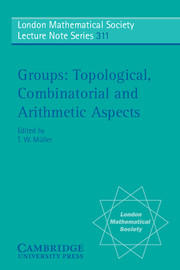Book contents
- Frontmatter
- Contents
- List of authors and participants
- Preface
- 1 Reductive groups as metric spaces
- 2 Finiteness properties of groups acting on twin buildings
- 3 Higher finiteness properties of S-arithmetic groups in the function field case I
- 4 Controlled topology and group actions
- 5 Finiteness properties of soluble S-arithmetic groups – A survey
- 6 Topology in permutation groups
- 7 Euler characteristics of discrete groups
- 8 Intersections of Magnus subgroups of one-relator groups
- 9 A minimality property of certain branch groups
- 10 Lattices with non-integral character
- 11 Some applications of probability in group theory
- 12 Parity patterns in Hecke groups and Fermat primes
- 13 Automorphisms of the binary tree: state-closed subgroups and dynamics of 1/2-endomorphisms
- 14 The mapping class group of the twice punctured torus
- 15 Kac–Moody groups: split and relative theories. Lattices
- 16 On the finite images of infinite groups
- 17 Pseudo-finite generalized triangle groups
14 - The mapping class group of the twice punctured torus
Published online by Cambridge University Press: 04 November 2009
- Frontmatter
- Contents
- List of authors and participants
- Preface
- 1 Reductive groups as metric spaces
- 2 Finiteness properties of groups acting on twin buildings
- 3 Higher finiteness properties of S-arithmetic groups in the function field case I
- 4 Controlled topology and group actions
- 5 Finiteness properties of soluble S-arithmetic groups – A survey
- 6 Topology in permutation groups
- 7 Euler characteristics of discrete groups
- 8 Intersections of Magnus subgroups of one-relator groups
- 9 A minimality property of certain branch groups
- 10 Lattices with non-integral character
- 11 Some applications of probability in group theory
- 12 Parity patterns in Hecke groups and Fermat primes
- 13 Automorphisms of the binary tree: state-closed subgroups and dynamics of 1/2-endomorphisms
- 14 The mapping class group of the twice punctured torus
- 15 Kac–Moody groups: split and relative theories. Lattices
- 16 On the finite images of infinite groups
- 17 Pseudo-finite generalized triangle groups
Summary
Introduction
Let Σ be a (possibly punctured) surface of negative Euler characteristic, and let C(Σ) be the set of isotopy classes of families of disjoint simple closed curves on Σ. When Σ is a once punctured torus Σ1, there is a well known recursive structure on C(Σ1) which arises from the relationships between C(Σ1) (identified with the extended rational numbers), continued fractions, and PSL(2, ℤ) (the mapping class group of Σ1). The results in this paper arose out of a search for an analogous structure on C(Σ2), where Σ2 is a torus with two punctures. Masur and Minsky have recently described an alternative approach. Our method is motivated by the Bowen-Series construction of Markov maps for Fuchsian groups. This generalised the relationship between PSL(2, ℤ) (now thought of as a Fuchsian group acting in the hyperbolic plane) and continued fractions (now thought of as points in the limit set of PSL(2, ℤ)), to a large class of Fuchsian groups Γ. The Markov map was a map on the boundary at infinity, in other words the limit set Λ(Γ), which generated continued fraction expansions for points in Λ(Γ), and whose admissible sequences simultaneously gave an elegant solution to the word problem in Γ (see Section 1.1 below).
The idea behind this paper rests on the analogy between Γ acting on the hyperbolic plane and the mapping class group acting on Teichmüller space.
Information
- Type
- Chapter
- Information
- GroupsTopological, Combinatorial and Arithmetic Aspects, pp. 405 - 486Publisher: Cambridge University PressPrint publication year: 2004
Accessibility standard: Unknown
Why this information is here
This section outlines the accessibility features of this content - including support for screen readers, full keyboard navigation and high-contrast display options. This may not be relevant for you.Accessibility Information
- 1
- Cited by
